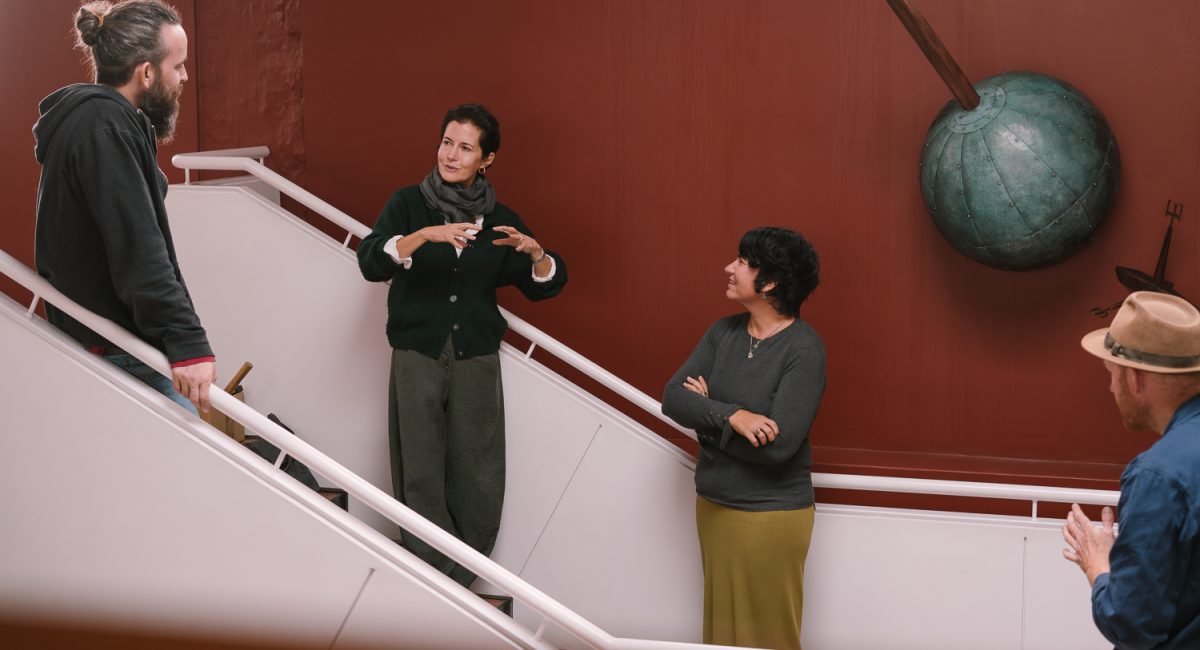
In conversation with CHR staff and fellows on the day of the handover, Vives explained:
“
His really radical perception was the idea of the great infinite he called the apeiron, essentially speculating on the plurality of worlds and the ceaseless flux of the cosmos at a time when little was known about the universe and it was presumed that our world was its centre.
“
Often regarded as the father of Western cosmology, Anaximander proposed in the 6th century BCE that the Earth floats freely in space—suspended in the apeiron—and that therefore the sky continues not only above but beneath our feet.
“
He laid the foundations for what one would call Western astronomy. Of course, people gazed at the stars throughout the world—and there is evidence of early astronomers and African cosmologies, not just transmitted through oral traditions, but through the markers they put in place, which include the megalithic stone circle at Nabta Playa in southern Egypt. They aligned with the summer solstice sunrise over a millennium before Stonehenge. And also the star-based calendars of ancient Egypt, and Southern African rock engravings that tracked lunar cycles and seasonal change.
So, in thinking about the Western view of the world that was shaped through travel, conquest and colonialism, I decided to submerge a particular part of the globe in the work – the Northern Hemisphere and the West – and to have only the cardinal points of South and East on the spire.
“
While The Sky Beneath draws on Anaximander’s vision of the apeiron and the symbolic history of the time-ball as a Western device for measuring and asserting temporal order, its deeper aim is to disrupt inherited geographies and fixed perspectives. It proposes an alternate worldview: one that recentres the Global South, dissolves colonial borders, and reimagines the Earth not as a divided map, but as a drifting planet shaped by deep time and a shared horizon. It is a meditation on cosmology, disorientation, and the human condition within the vast unknown.
Etched into the surface of the sphere is not a map of nations, but the hidden geography of the ocean floor—an unfamiliar world of submerged ridges, trenches, and abyssal plains. The Southern Hemisphere is placed at the centre, with the African continent—and the southern tip of Africa—rising as a dominant high point. Vast regions of the Northern and Western Hemispheres lie submerged, their outlines eclipsed by an inverted cosmology. The Mid-Atlantic Ridge—the world’s longest mountain range—cuts across the seafloor, evoking the tectonic drift and deep-time ruptures that support the widely accepted theory of Pangaea.
“
This particular work was part of a series I developed and exhibited under the title ‘Eternal Circumstances’, in response to salvaging hand-drawn star charts from the Jagger Library after the fire. They were about to be disposed of, heavily burnt, partially wet and covered in mould. I spent several months trying to sort several hundred charts of the entire Southern Hemisphere constellations, and that’s really what deepened my interest in astronomy and cosmologies.
“
Formally, The Sky Beneath also has the properties of a fallen time-ball—once a critical maritime signalling device that enabled navigators at sea to calibrate their chronometers by the transit of the sun and stars, essential for calculating longitude. In South Africa, the first time-ball was erected in Observatory, Cape Town—close to the CHR’s Iyatsiba Lab—before being relocated in the 1860s to Signal Hill, its visibility from the harbour eventually obscured by the growing city. In the 1930s, it was installed at the V&A Waterfront clocktower, where it remained a landmark until its removal in early 2025. Its movement was long triggered electronically by the South African Astronomical Observatory, echoing Greenwich and other maritime centres of the colonial world.

